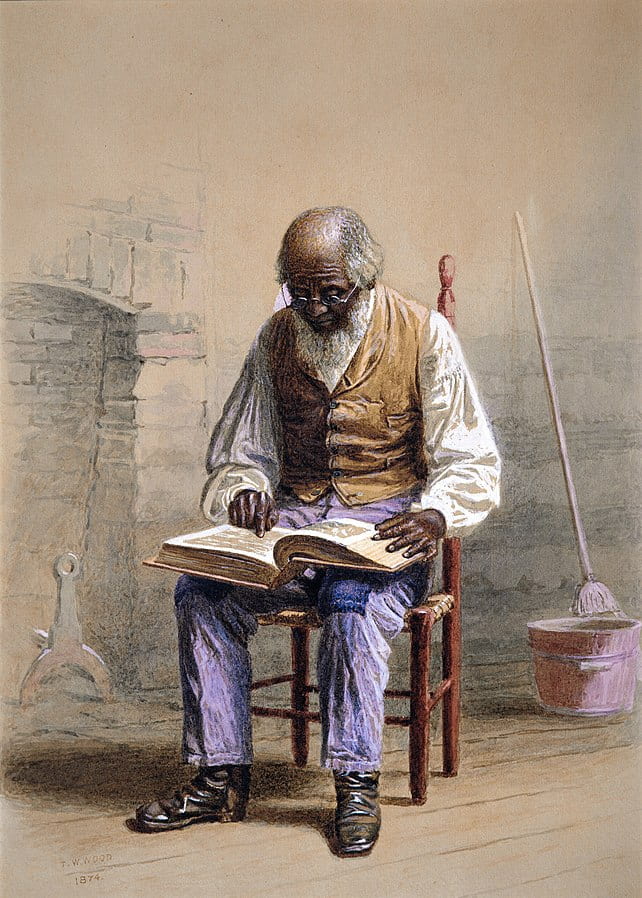
Reading the Scriptures by Thomas Waterman Wood, 1874.
Here are a few of the pieces the team at the JHI blog have been reading over the last week:
Derek
“The World in Time”: Interview with Eric Foner (Lapham’s Quarterly)
Anton Jaeger, “The Myth of Populism” (Jacobin)
Richard Holmes, “Out of Control” (NYRB)
Irvine Loudon, “A brief history of homeopathy” (JRSM)
Eric
Branko Milanovic, “What these early-2oth-century scholars got right” (Vox)
Eleanor Robertson, “Intersectional Identity and the Path to Progress” (Meanjin)
Nathan Robinson, “Orders from above” (Current Affairs)
Michelle Wolff, “Symposium: Ahmed, Living a Feminist Life” (syndicate)
Disha
Zoë Carpenter, “If We Lose Our Healthcare, We Will Begin to Die” (The Nation)
Moira Donegan, “My Name Is Moira Donegan” (The Cut)
Joan W. Scott, “How The Right Weaponized Free Speech” (The Chronicle of Higher Education)
Anthony Oliveira, “The Year in Apocalypses” (Hazlitt)
Brendan
Melinda Cooper, “Family Values: Between Neoliberalism and the New Social Conservatism”
Polygon’s Year In Review, especially Charles Yu on Universal Paperclips (play the game, too)
My friend Ilan Moscovitz’s series on AI: (parts one, two, three and four) (The Motley Fool)
Spencer
Ayelet Wenger, “Hokhmat Nashim” (The Lehrhaus)
Andrew Butterfield, “Divine Lust” (NYRB)
Marcel Theroux, “The post-truth Gospel” (TLS)
Brook Wilensky-Lanford, “Jonas Bendikson: Among the Messiahs” (Guernica)
Michael Valinsky, “To and from the Linguistic Shore of Ismail Kadare’s ‘A Girl in Exile’” (LARB)
Sarah
Bryan A. Banks and Erica Johnson, “Religion and the French Revolution: A Global Perspective,” (Age of Revolutions)
Julie Green, “Movable Empire,” (Jacobin)
Jennifer Anne Hart, “The Crown Goes to Ghana? Media Representation, Global Politics and African Histories,” (Ghana on the Go)
Cynthia
If you are anything like me, you are probably still writing 2017 when you actually mean 2018. I spent New Year’s Eve and New Year’s Day moving, so I had precious little time to make New Year’s resolutions. Still, that didn’t stop me from considering how I might improve myself over the course of these next 52 weeks. Or are there now only 50 left? I guess that gives me 2 less weeks to improve myself to death. Alexandra Schwartz’s piece will have you alternately making — and unmaking — resolutions. Maybe just take her suggestion and just go read a novel. In any case, I should probably refrain from buying either self-improvement manuals or novels for quite some time, as the act of unpacking my library has left me exhausted. If only I could find my copy of Illuminations, I could read Walter Benjamin’s “Unpacking My Library.”
Note that Benjamin never wrote an essay on unpacking his wardrobe. But clothes, like books, are repositories for memories. Fashion’s ability to conjure worlds out of memories is used to great effect in a trio of recent movies–Lady Bird, I, Tonya, and Call Me By Your Name. Lady Bird’s director Greta Gerwig told Sam Levy, the film’s director of photography, that she wanted the movie to “look like a memory.” In an interview with Vanity Fair, Levy, Lady Bird’s costume designer April Napier and production designer Chris Jones discuss how they achieved this aesthetic. (An unexpected source of inspiration: Lise Sarfati’s portraits of young women.) Giulia Persanti had a very different approach to the costume design for Call Me By Your Name. Unlike the pointed specificity of Lady Bird’s costumes, Persanti’s costumes were only loosely anchored in the film’s time period (1980s Italy). In an interview with British Vogue, Persanti said, “My main focus was to make a period film in which the costumes didn’t stand out as too ‘period-y’. More important was to send a clear message of the personality and origins of each character, choosing to give a casual, timeless, intimate style with a hint of inhibited adolescent sexuality.” I, Tonya has a very different relationship with clothing and memory. Jennifer Jones, the costume designer for I, Tonya, wanted to avoid saddling her characters with excessive nostalgia or kitsch. Jones discusses her approach in interviews with Entertainment Weekly and Deadline. Jones also wanted to avoid creating a caricature Tonya. Here, the clothes help open up the audience’s understanding of each character’s psychological development. We knew Tonya–and the people around her–primarily as tabloid and tv fodder. Jones hoped her costumes would restore some measure of their humanity, the humanity denied them when they were mocked, reviled–and played for laughs.



Leave a Reply